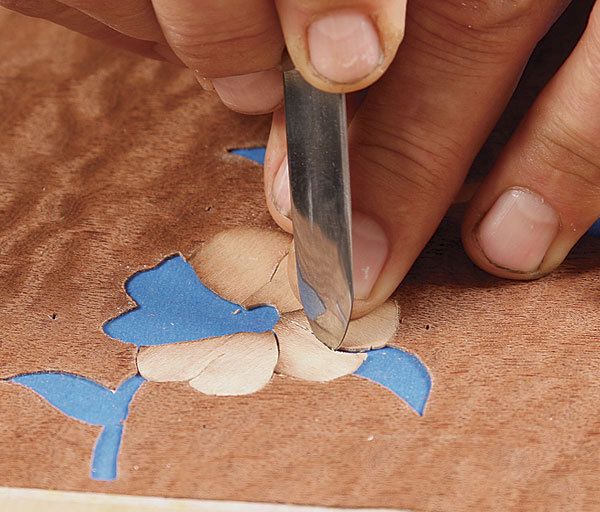
Synopsis: Paul Schurch learned marquetry in a furniture shop in Italy, and the techniques of knife-cutting, packet-cutting, and contour-cutting that he uses make it possible to produce any design more quickly and easily than other methods. Packet-cutting is simply stacking various veneers on top of each other and scrollsawing the pattern simultaneously in both the background and the picture veneers. You then select the right pieces and reassemble them like a puzzle. Learn how he does it, and turn to Master Class to see how to use the classic technique of sand-shading to add shadows to your designs.
From Fine Woodworking #225
I didn’t know much about marquetry when I got my first big table job in California in 1989. I decided to inlay the solid maple top with wood and stone designs by shaping the inlay, routing out the background, gluing the inlay into the recess, and sanding it flush. I got the job done, but I knew there had to be an easier way.
This spurred me to head back to Europe, where I had done my original woodworking training. There I found work in an Italian shop, producing marquetry for the furniture trades, and learned the efficient techniques of knife-cutting, packet-cutting, and contour-cutting that I still use and teach today.
The three techniques are complementary, and allow me to produce any design I can come up with. They require little investment in tooling, are easier and faster than other methods, and deliver better results. This article builds on an earlier one, “Decorative Veneering” (FWW #164), where I showed how to do a four-way bookmatch, stringing, and a border using the knife-cutting technique.
These elements combine wonderfully with the marquetry in this article, where I use packet-cutting to quickly create pictures in wood. By the way, to add depth and realism to these pictures, I also use sand-shading, a classic scorching technique for adding shadows.
If you haven’t tried marquetry, you will be surprised at how simple, practical, and fun it can be. To demonstrate, I’ll create a panel of three flowers, with leaves and a curving stem. You will need a basic scrollsaw that can hold a 2/0 blade, and for larger projects, you’ll need a vacuum bag to glue the veneers onto a core. I also recommend thin tongs, for handling the pieces, and a 23-gauge pin nailer, though hand-nailing the packet also works.
Why packet-cutting? Packet-cutting is simply stacking various veneers on top of each other and scrollsawing the pattern simultaneously in both the background and the picture veneers. You then select the right pieces and reassemble them like a puzzle. The kerf is not an issue, since the 0.008-in. gaps created by the blade are so thin that the gluing and finishing process fills them. I also use the sawkerf lines as a design element, as in leaf veins or other accent lines in the design. The beauty of packet-cutting is that when you wander slightly off the line, the background and the design will still fit. Also, a single packet can yield multiple versions of the same design.
For the full article, download the PDF below.
Fine Woodworking Recommended Products

Whiteside 9500 Solid Brass Router Inlay Router Bit Set

Bahco 6-Inch Card Scraper





















Log in or create an account to post a comment.
Sign up Log in